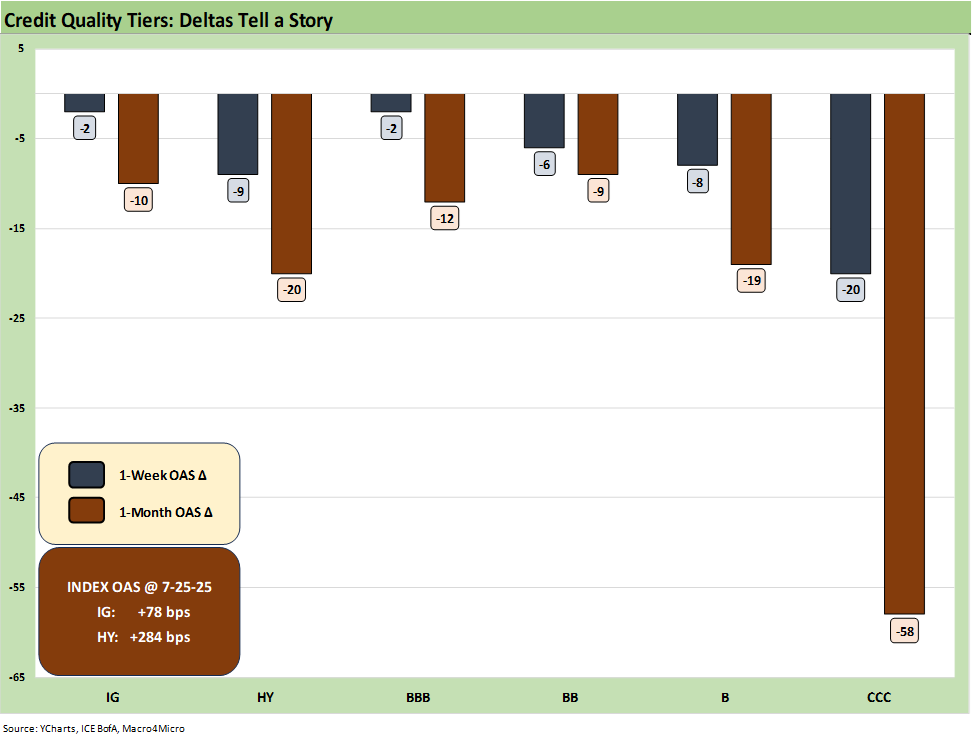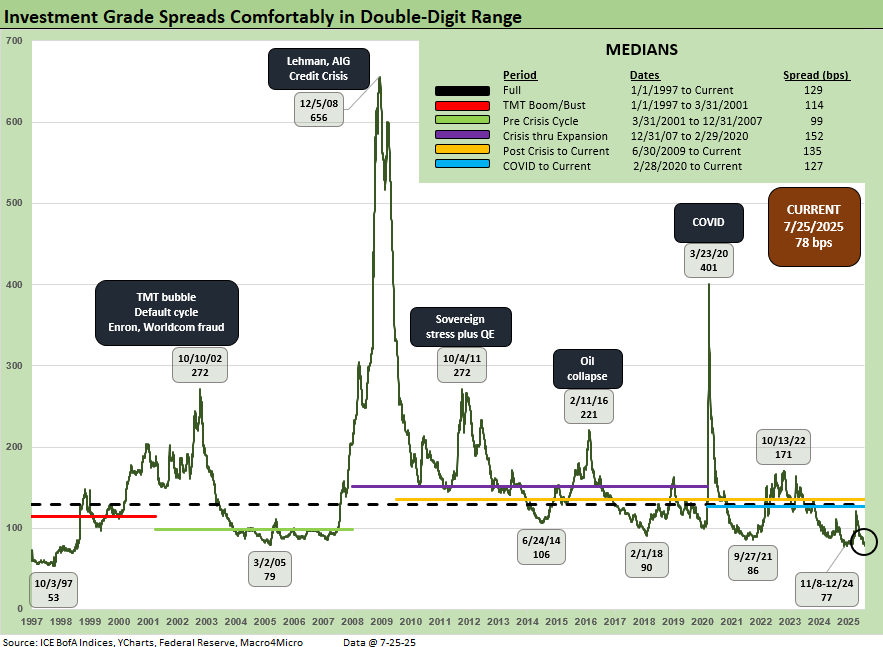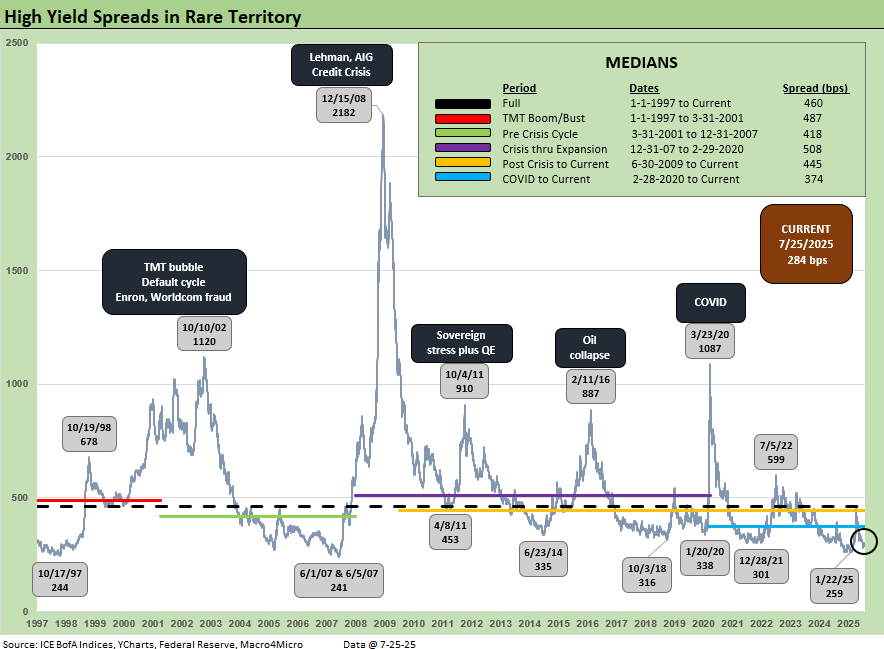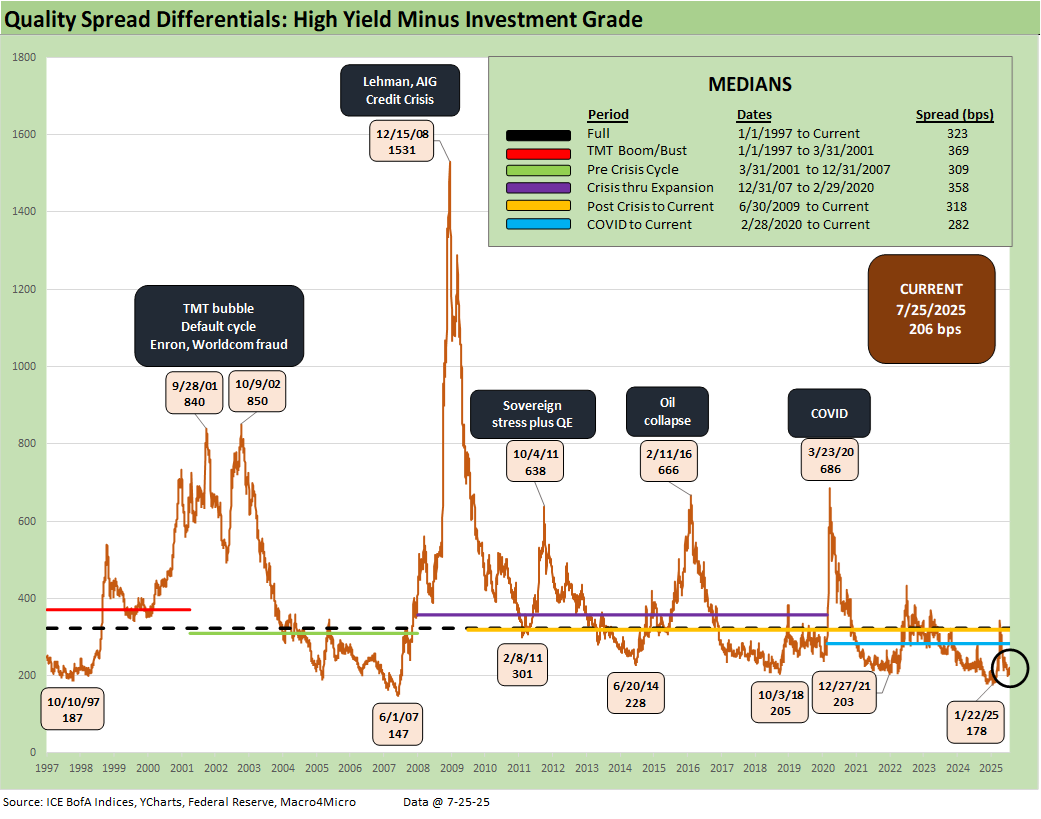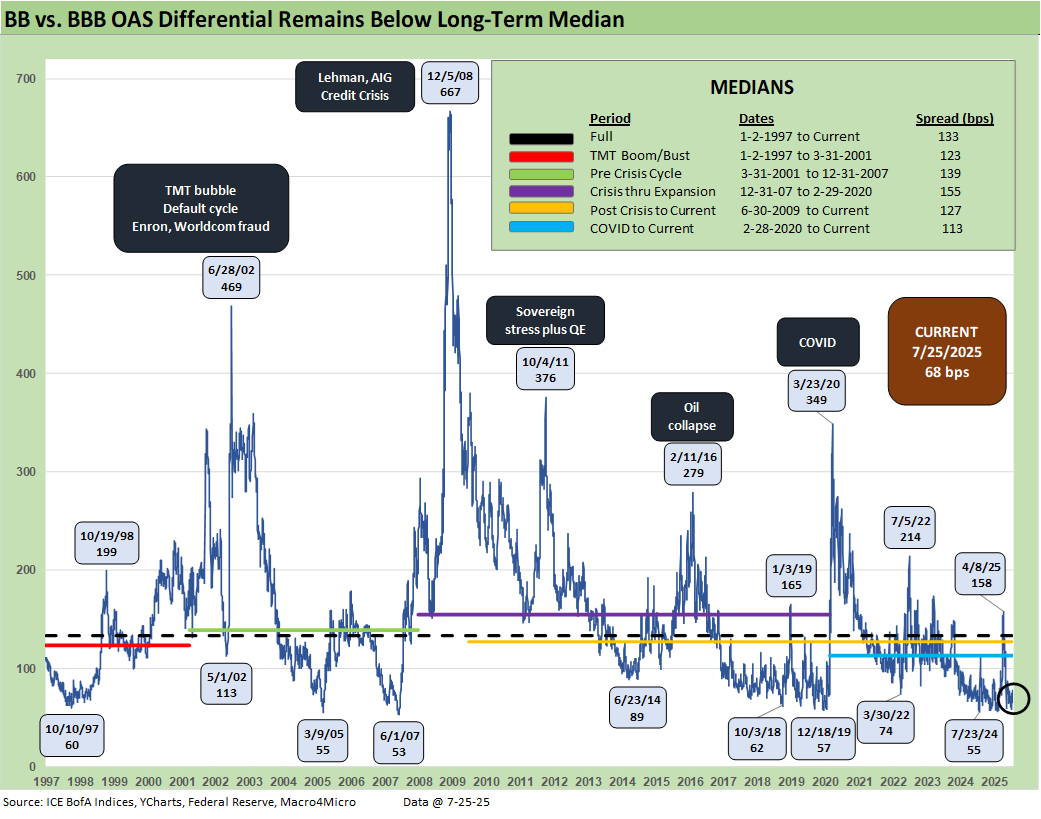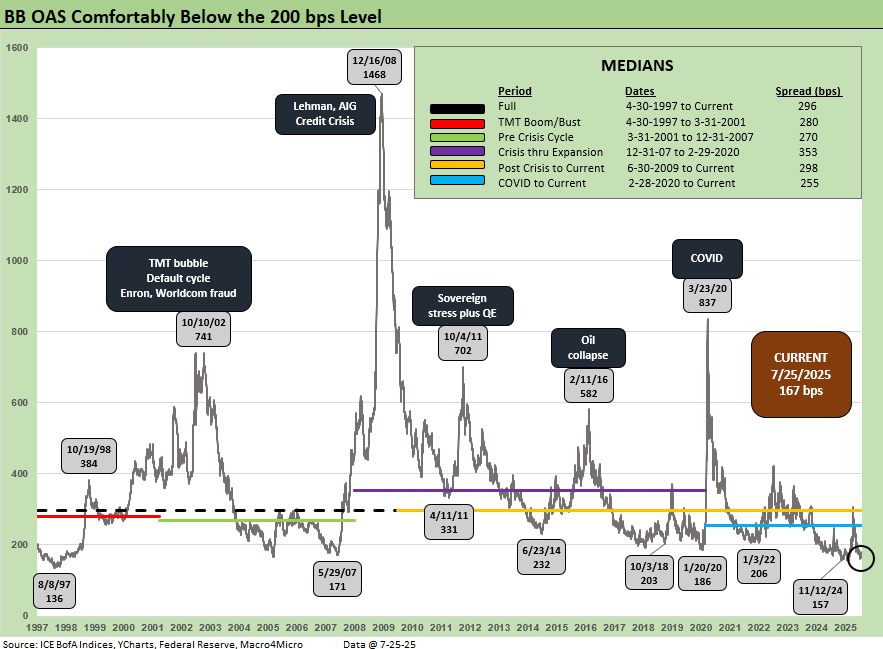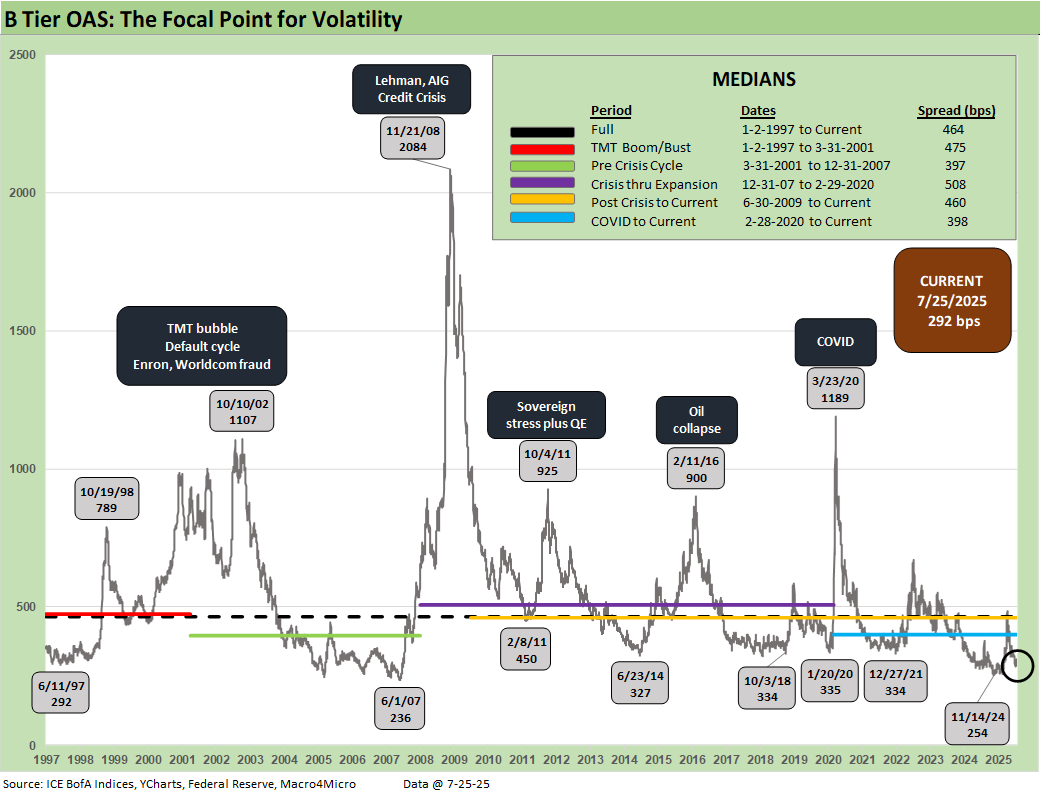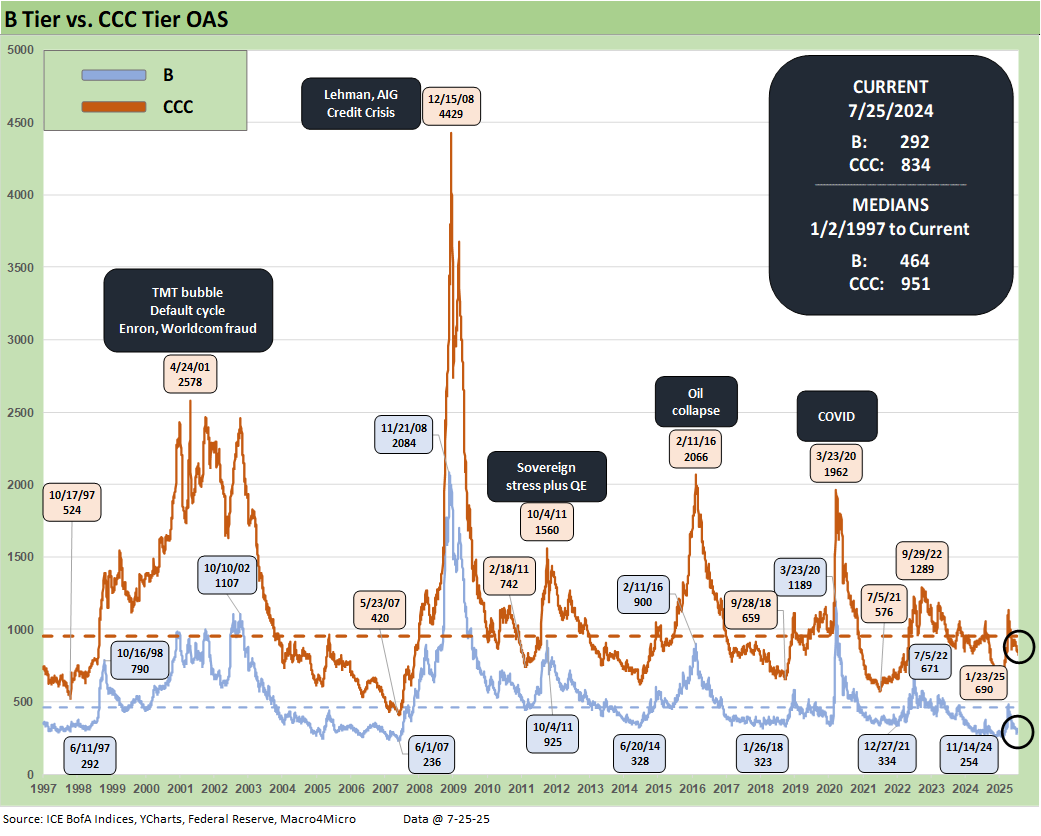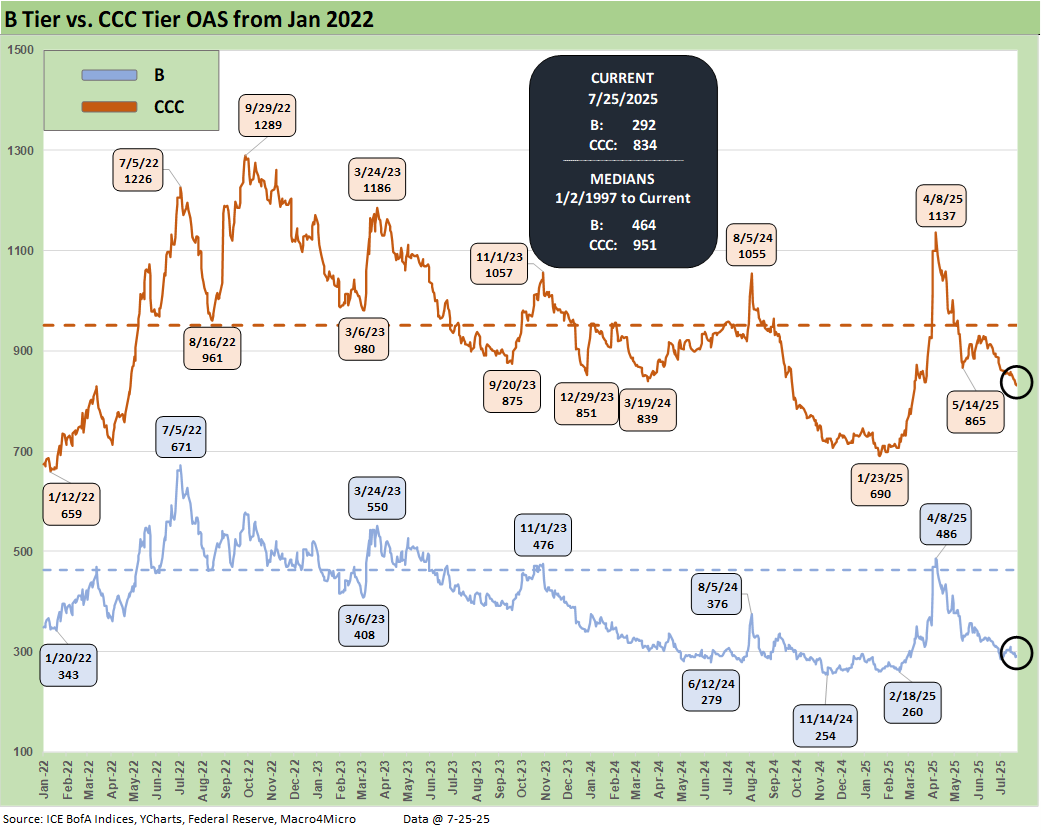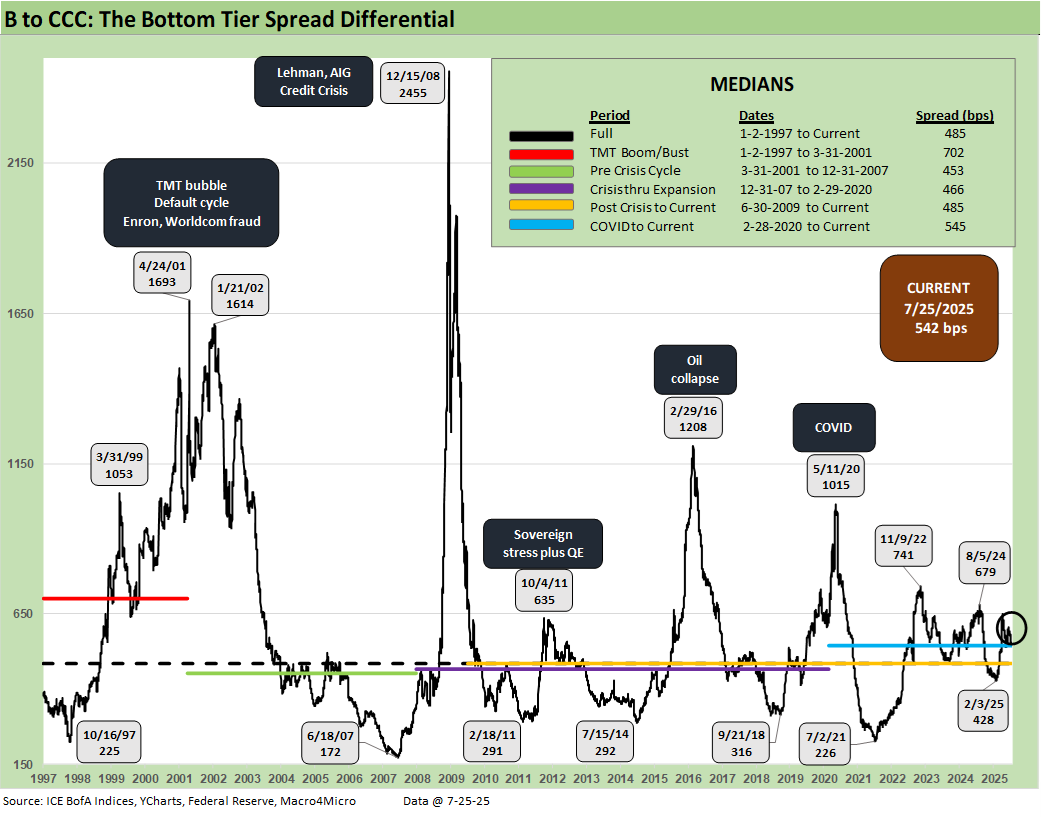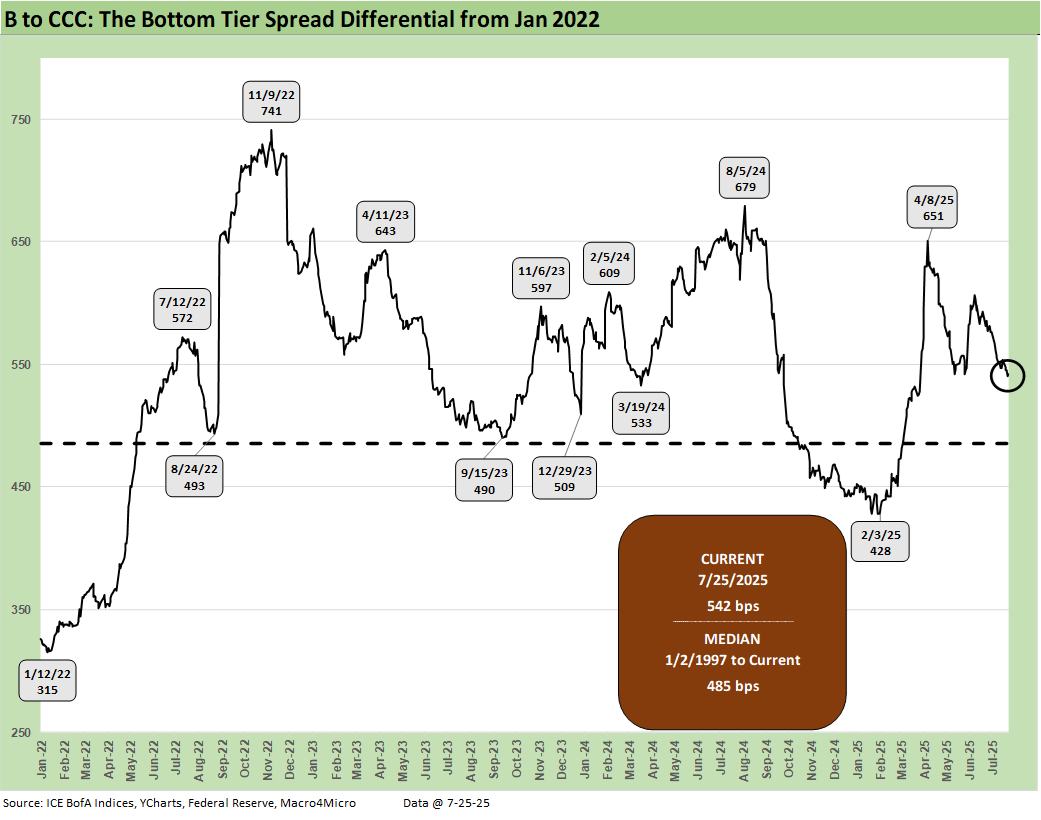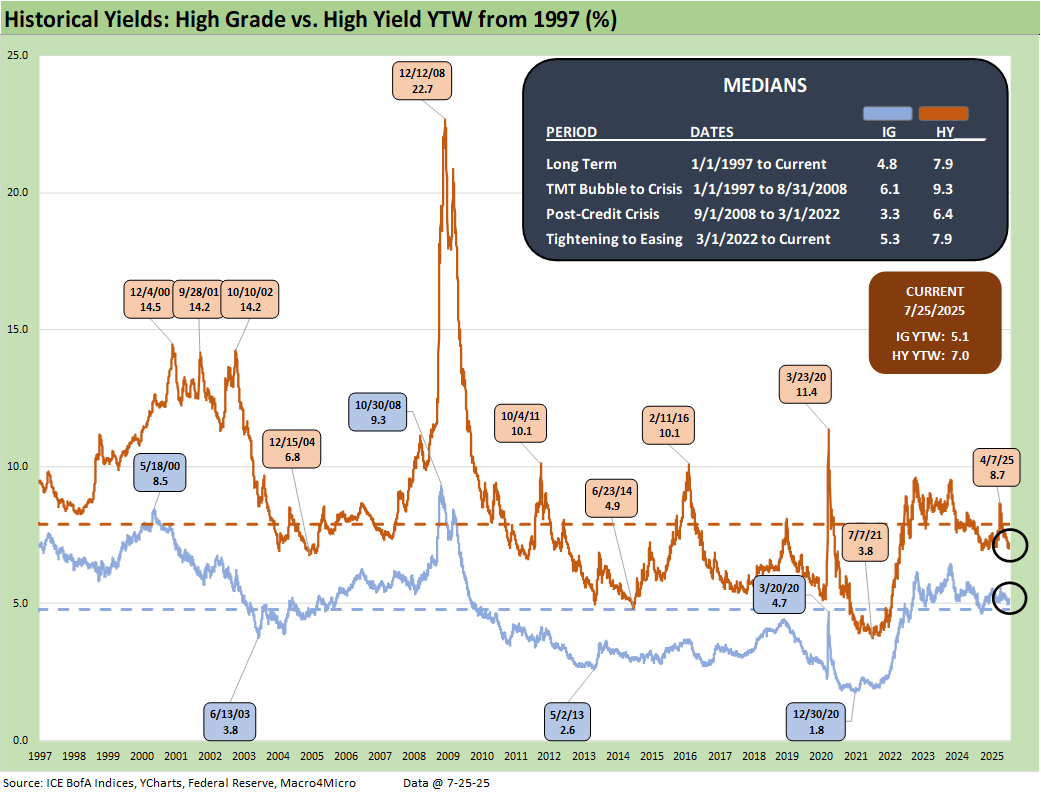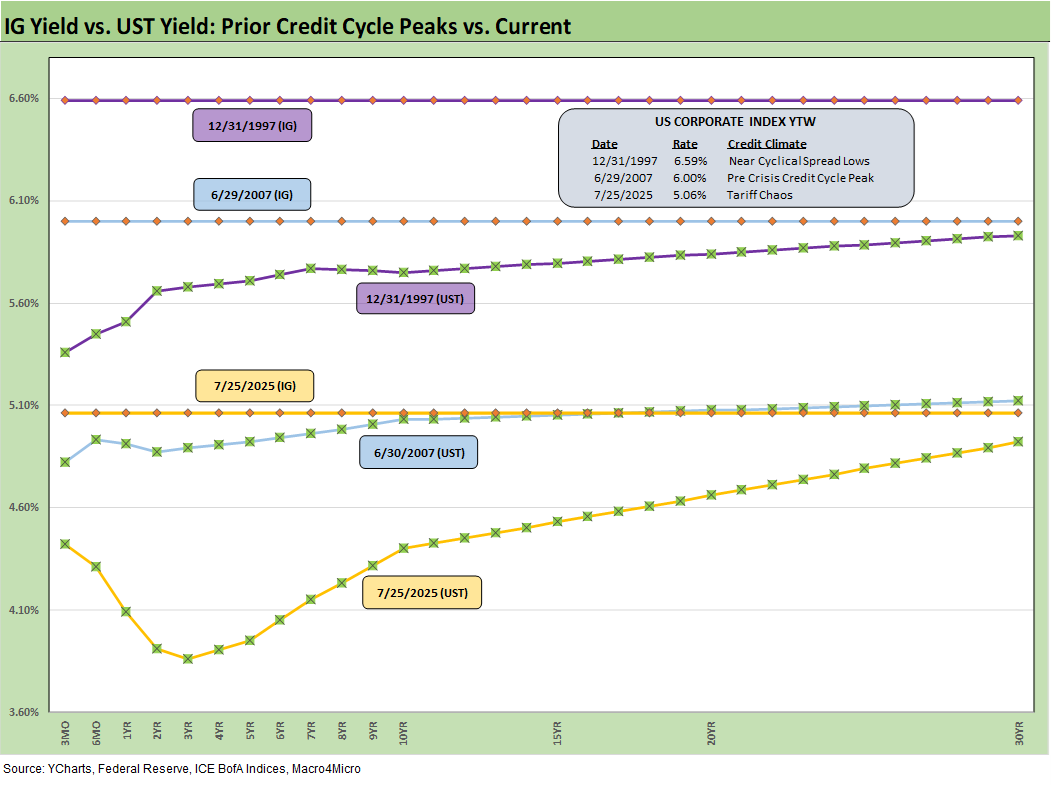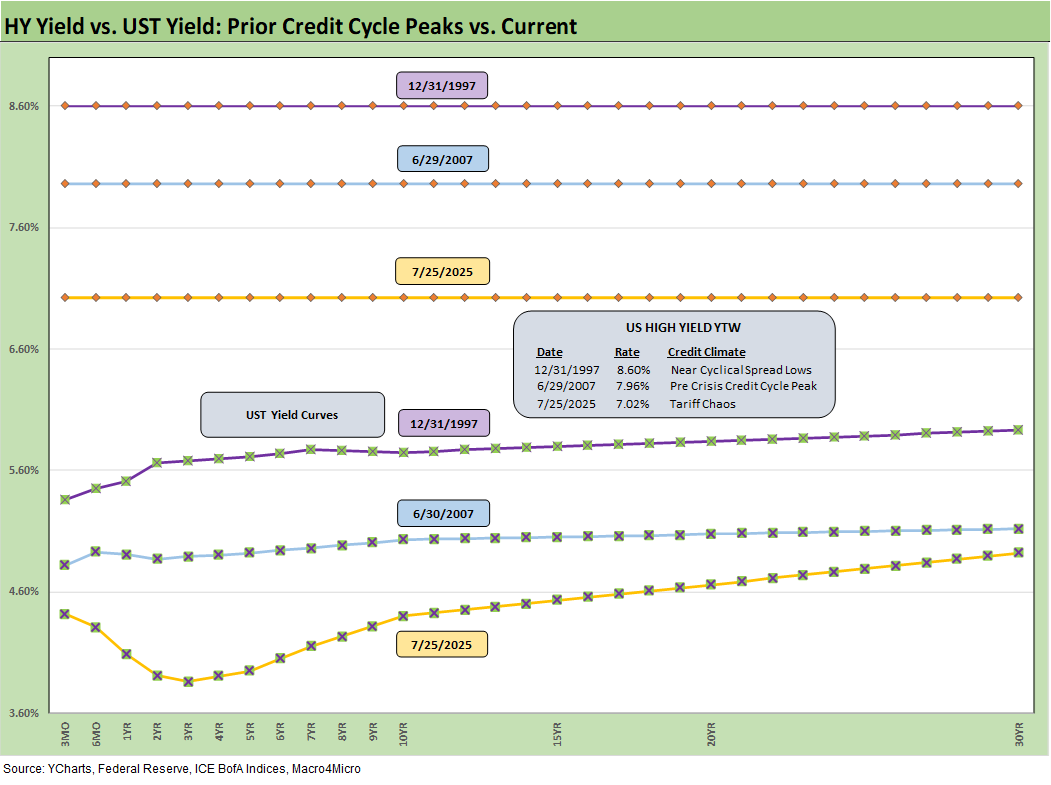Footnotes & Flashbacks: Credit Markets 7-28-2025
We update our rolling credit markets commentary as spreads resume their march back to June 2007 levels.
I hope it’s deep enough…
Spreads tightened further this week with IG and HY narrowed by -2 bps and -9 bps, respectively, from already tight levels. Despite some softer economic data and early earnings concerns, the lack of clear downside catalyst in the cycle plus declining trade war risk (EU, Japan) sees spreads still grinding towards the June 2007 credit bubble peak.
Earnings season so far has shown that there is still room to maneuver and levers to pull to avoid the worst tariff scenarios across major bellwethers. However, Retailers, Autos, and small businesses are seeing the material impact already. The inevitable turnover of working capital cycles will eventually play out in the larger picture of how tariff outlays are absorbed.
The positive news of progress on EU and Japan trade “deals” at least sets up a framework that takes some major trade war risks off the table. Mexico and Canada remain open items, and the 15% EU headlines for EU and Japan could provide a path for further de-escalation if that level becoming the de facto baseline. US-China talks in Stockholm this morning leave some tail risk with a potential snapback, but that is less likely to given the rolling pause strategies that have worked with China risk mitigation so far.
This week sees a wave of major events with a FOMC meeting, PCE inflation, Income and Outlays, the first 2Q25 GDP estimate, and JOLTS and payroll. The major economic data coincides with a major wave of earnings as 4 of the Mag 7 and some major industrial bellwethers chime in.
Below we update our rolling weekly credit markets commentary and spread recap. We already addressed a range of moving parts in our earlier posts over the weekend:
Footnotes & Flashbacks: State of Yields 7-27-25
Footnotes & Flashbacks: Asset Returns 7-27-25
Mini Market Lookback: Mixed Week Behind, Big Week Coming 7-26-25
The above chart updates the credit spread deltas for 1-week and 1-month, where spreads resumed a slow tightening trend, led by HY moving down to +284 bps. These levels puts us in historically rich territory near the upper end of the June 2007 range and well below the 2014 and 2018 cyclical lows. Overall, spreads this week tightened across the board with quality spread compression including CCCs seeing the largest move of -20 bps to +834 bps.
After the multi-month stretch that saw a major bout of tariff driven volatility, the market is settling towards a wait-and-see pattern on inflation risks and Fed instability with more muted sensitivity to trade headlines. The reaction to Japan and EU trade deals reflect how ingrained this pattern has become as the Aug. 1st deadline remains on the radar for some key trading partners.
For now, attention has pivoted toward a very busy macro release lineup and a major 2Q earnings week with a focus on forward-looking guidance. The shift in focus from trade war risk is welcome, but the portfolio level implications of tariffs remain an open question that require continued monitoring given the intrinsic lag effects that disinformation and “politicking” has sought to downplay (“seller pays” etc.).
Early earnings commentary confirms that tariff impacts are realities and that they carry real and immediate effects on the expense lines. The pricing reactions are “for later” in many industries. The next leg of the analysis is how forward-looking views fare as pricing strategies are “market tested” at sea level in the later summer and fall as economic releases and pricing data show up at a lag. That is when the tariff impact will rise back up into the inflation debate and Fed policy battles.
Tariffs remain a highly politicized topic and information focus of often tapered to the needs of the parties debating the topic. We are most disturbed by the lack of focus on the small business sector fallout and how that rolls up to the macro level. Digging into small business trade groups – and notably small retailers – tells an uglier story.
For HY spreads, the rally back to sub +300 level in HY has been a vote of confidence in the balanced overall credit picture and the better positioning in higher income, shorter duration assets during a period of UST uncertainty. The BB heavy weighting of the HY index has been supportive of returns as noted in the next chart.
The above chart updates the YTD total return and excess return for IG and HY as well as the credit tiers. Excess returns are still not impressive with little upside potential from spread compression, but IG and HY are at least solidly positive at this point. New issues in HY also have the “coupon edge” for income seekers. A 7.02% composite HY YTW tells a favorable story of cash income in new issue flows and refi-and-extension actions. The current composite HY coupon is 6.55%. There is a wide range of coupons in the post-ZIRP world, so new issues in HY hold a lot of allure.
Total returns show the benefits of the modest bull steepener that has supported the short to intermediate UST curve segment (see Footnotes & Flashbacks: State of Yields 7-27-25). That duration angle can support the trade-off along the BBB/BB divide for the now well-established HY Light strategy.
The double-digit IG spreads at +78 bps are back near prior cyclical lows and just above the 4Q24 lows of +77 bps. The long-term IG OAS median of +129 bps leaves a lot of room but drives home how this market is priced in a rarefied spread range. With a 5.06% yield offered by the IG index, current coupon new issues whether “new money” or refinancing low coupon bonds bring a very solid base of demand after years of ZIRP and normalization coupon levels in portfolios. Income is back in the picture this credit cycle.
HY spreads tightened -9 bps to +284 bps, and HY OAS is now in a very rare territory with a 200-handle that is more in line with the June 2007 and recent 1Q25 lows. We saw a long stretch of 200-handle HY spreads back in the 1997 credit cycle peak as well. These levels are inside the pre-COVID Jan 2020 levels and the prior cyclical lows of Oct 2018 and Jun 2014. The recent 2024 lows of +260 bps and +259 bps in Jan 2025 mean the uber-bulls will stay in the game, but even with tariffs moving to the 15-20% range (and higher), there are still hurdles coming after Aug. 1st.
The consumer is also showing signs of slowing down as noted in numerous recent releases with back-to-school season coming up. We get a new set of personal income and outlays data late this week with PCE inflation that will test the constructive retail sales numbers from this past week. That presents a delicate balancing act for the FOMC amid stagflation concerns.
The “HY OAS minus IG OAS” quality spread differential at +206 bps did not move much this week but broke through the Dec 2021 and early Oct 2018 levels. The compressed level still allows little room for setbacks in fundamentals at the macro level and a 15% baseline tariff level is a clear catalyst for some issuer and broader economic pain as those tariff impacts flow into pricing and expenses. Correlation with potential equity volatility is a constant companion for HY as seen in April, but the overall fundamentals are solid in the IG and HY issuer base with earnings signaling still-healthy banks and generally well managed tariff costs so far. The supplier chain adjustment process will remain a major headwind for many industries.
The “BB OAS minus BBB OAS” quality spread differential narrowed -4 bps this week to +68 bps. The BB/BBB divide can swing around as we saw with the spike to +158 bps after Liberation Day. Autos and Energy will be important sectors to watch for potential volatility in those tiers with Autos already reporting major tariff costs.
The oil price story is always a tricky one for issuers with high commodity exposure with Iranian and Russian supplies no small wildcards. OPEC actions also have been less than friendly to energy bulls in 2025. At just over $66 today (WTI), oil is below the Iran bombing highs but well above the late May $60 level.
For autos, it is very hard to see any good news coming out of the trade policies. We will see Stellantis headlines kicking in with more detail with earnings this week along with Ford and some major suppliers and dealers too. There is only “degrees of bad” for the OEMs from tariffs and potential catastrophe for some OE suppliers. Dealers and auto retail are the most resilient and the OEMs will need to take action to support their retail customer strategies.
There will be much to sort through in the auto sector in 2H25 including the cost impact of high tariffs on steel, aluminum and copper. The Mexico impact on production chains will be an especially important variable for US suppliers and OEM cost structures with GM’s exposure on light vehicle supply a critical factor.
The sub-200 BB tier OAS line is a rare one to cross and we remain there after a -6 bps move this week to +167 bps. That is not too far above the dazzling +157 bps low of Nov 2024 after crossing below the May 2007 low. Oct 2018 lows of +203 bps is a notable comp for a frame of reference, given the timing of the fresh sell-off in energy into Dec 2018. Though the current levels are vulnerable given the extraordinarily tight pricing, the higher quality index and low default rates leave plenty of room for rationalization of these levels. For longer time horizons, the BB tier has been a great place to be.
The B tier is the sweet spot of legacy HY fund investors and the current +292 bps is well inside Oct 2018 and June 2014 lows and -172 bps below the long-term median.
The B vs. CCC tier OAS time series is plotted above. The timeline for B and CCC spreads highlights the points of major divergence along the way (see The B vs. CCC Battle: Tough Neighborhood, Rough Players 7-7-24).
The current CCC tier OAS at +834 bps tightened by -20 bps the past week and remain well under the long-term median of +951 bps. The CCC YTW stayed below 13% at 12.40% after being above 14% in the Liberation Day sell-off. The underlying constituents are widely dispersed across an 83.58 composite dollar price. The CCC tier is still in the pricing zone of equity-like risk-returns with such yields.
The shorter timeline from Jan 2022 just ahead of the end of ZIRP and start of the tightening cycle gives better granularity on the movements from a low for CCCs of +659 bps in Jan 2022 to a peak of +1226 bps in July 2022 and +1289 bps to end Sept 2022. Then spreads came down to the Jan 2025 tights of +690 bps ahead of the recent spike and whipsaw to current levels that remain wide to those early 2025 lows.
The B vs. CCC tier differential is broken out with the current +542 bps still higher than the long-term median of +485 bps and above the distinct market time horizons with the exception of the TMT HY credit cycle with its +702 bps median. The risks this year have seen CCC tier spreads remain wider by +88 bps YTD after the earlier whipsaw while the B tier swung back to -4 bps tighter YTD.
The above chart frames the “B vs. CCC tier” quality spread differential across the short timeline for better granularity. Quality spreads had widened with a vengeance since the low of Feb 2025 at +428 bps even if quality spreads recovered to +542 bps from the early April spike of +651 bps on April 8.
Moving away from spreads, which are well below long-term medians, yields for both IG and HY have a more complex story in historical context given the post-crisis distortions of ZIRP and “normalization.” The normalization period of Dec 2015 to Dec 2018 never really got on track with the economic weakness and Fed easing of 2019 followed by a COVID crisis and return to ZIRP in Mar 2020 (ZIRP ended March 2022). As a reminder, 2018-2019 was the “Greatest Economy in History” according to the current White House resident. As we’ve covered in past commentaries, the numbers do not agree with that assessment – not even close.
The current IG YTW at 5.06% (vs. 5.11% last week) moved lower with spreads as the UST was more mixed. IG YTW remains below the 6.1% pre-ZIRP median on overall YTD UST curve moves.
The HY YTW decreased to 7.02% this week (from 7.11%) vs. a pre-ZIRP 9.3% median. We consider the pre-ZIRP years the most rational frame of reference in light of the post-crisis ZIRP and QE as well as the COVID Fed reactions.
Spreads will remain a key swing factor for reaching those yield medians of pre-ZIRP years, and we just saw material volatility in credit risk pricing in HY since early April. Then came a fresh rally after Iran and optimism on how the tariff pause will play out after a Vietnam deal framework was in hand. That optimism continues after Japan and EU deal frameworks in hand after this weekend but there is still a final round of tariffs to wind down before the pause ends. The market has reacted in a muted fashion to the latest tariff news.
UST yields are a tougher call with the tariff backdrop still threatening stagflation as well as the potential for a further technically driven upward UST curve shift on the supply-demand fears. Stagflation risk remains in the debate.
Away from stagnation + inflation, old fashioned recession risk would pressure UST rates lower and credit spreads higher, but this is no ordinary cyclical turn. We cover the UST shapeshifting in our separate Footnotes publication on the State of Yields as the UST curve saw the 5Y to 30Y move lower while the short end rose slightly.
The market could (and should) react negatively to any success by Team Trump to terminate Powell to complete the sweep of complete control over all fiscal, monetary, and trade policy by Trump. This past week saw continued attacks launched on Powell culminating with the Trump visit to see the Fed construction.
Trump brought Tim Scott to the Fed construction “tour” with his OMB Director (Russell Vought) in tow. Neither one has any background in monetary policy or training in economics or bank regulatory experience of any significance. We would say that being on the banking committee (Scott) is about power and not expertise. For those of us who have had some limited dealing with bank committee legal advisors, the challenges these committees must deal with are not matched by the diligence or the knowledge of the decision makers. Welcome to Washington.
In similar fashion, Vought from the OMB was the architect and co-author of Project 2025, and he has been angling to subjugate the Fed to the White House. His allies have a goal of materially contracting Fed authority to price stability only (see Chapter 24 of Project 2025). Ponder what would have happened in March 2023 with the depositor run on the regional banks (stake even higher during COVID and the ban system crisis of 2008). To the extent such decisions outside inflation were directly controlled by the White House, you can imagine the motives of various parties behind picking winners and losers. That process would be risky with political appointees as decision makers handicapped by leaders with political motives and an inadequate understanding of the systemic knock-on effects.
The Fed needs to be independent, especially when the main obstacle to easing is the Trump tariff excess. The market will not like a violation of that core principle. Bessent was on the screen last week pitching a review of the entire Fed framework which was essentially a poor rehash of maybe a few lines of Project 2025’s Chapter 24. He made fun of PhDs (always a crowd pleaser) but said very little of substance. Bessent has been one of the major disinformation channels on how tariffs actually work (see Tariffs: A Painful Bessent Moment on “Buyer Pays” 5-7-25).
The above frames current IG index yields vs. previous credit peaks along with their respective UST curves. We include both prior credit peaks in June 2007 and Dec 1997 for context as prior peak credit cycles featured high risk appetites and saw investors chasing yields. Those 1997 and 2000 markets saw poor risk symmetry and low spreads.
Today’s UST curve is still low in the context of those historical credit peaks. We saw a recent glimpse of rising long yields along the timeline and the return pain that comes with it. The focus remains on the budget deficit and UST supply as the main driver for duration risk here as we get clarity on the size of the deficit increase. Expected revenues flowing into the US Treasury from tariffs come with the potentially conflicting impact of lowering imports and undermining domestic tax revenue if the cycle weakens.
Reagan got a taste of disappointing tax revenues in the 1980s that caused him to reverse some tax policies (notably on the corporate side). The growth stimulus from the One Big Beautiful Bill may fall well short with few forecasts above 2% GDP growth in the markets. The Fed, OECD, World Bank, and many major banks are calling for 1% handle US GDP growth this year and next.
Stagflation risks will stay in the mix with the current market beyond the credit cycle peak after the tariffs, and long-dated yields still could go easily higher along with spreads widening again for another round of return pain. The weak dollar has had the effect of making tariffs even more expensive for US buyers. The dollar at one point had seen its worst performance since the 1970s with a mild recent rebound. That is the exact opposite effect of what Ryan and Brady were promising back in 2017 with their Border Adjusted Tax proposals (aka BAT Tax or tariffs). That plan was supposed to replace corporate taxes. The GOP controlled Senate dissed their plan and did not even consider it. Times change.
The short to intermediate IG market is still the safest bond game for now. The funds that are asset class constrained to HY can take refuge in the higher quality layers. Overall corporate default risks in HY bonds remain in check (private credit is its own distinct story and mix).
The final chart does the same 1997 and 2007 drill but for HY index yields. This week’s UST move leaves HY index yields below prior peak credit cycles at 7.02% as of Friday vs. 7.96% in June 2007 and 8.60% in Dec 1997. The recent spread widening had moved HY index yields higher, but the recent reversal and rolling UST moves leave the current HY index YTW well below both the 2007 peak and 1997 HY index levels.
The widening during April gave flashbacks to the volatility and major spread moves of the 1997-98 and 2007-08 periods that also posted triple-digit widening months. The sheer speed of risk repricing that has happened in earlier cycles and with the Liberation Day shock offers reminders even if those moves were for very different reasons.
We would highlight that the quality of the HY mix (industries and issuers) is superior today to those in 1997-1998 and 2007-2008. That is especially the case in the IG financial sector vs. 2008, where some securities firms and some banks were like a grenade with a loose pin.
Below we roll forward some updated commentary on the credit cycle…
The challenge is identifying a fundamental transmission mechanism to more trouble for financial metrics and relative risks of default. Identifying a catalyst for pain in the current market would highlight tariffs or trade wars hitting the macro drivers (the consumer) and micro drivers of corporate profitability and cost mitigation actions to offset the tariff expense. The oft misrepresented “buyer pays” reality will hit margins or require higher prices.
The recent tariff strategy is both unpredictable and unprecedented in modern capital markets, but at least the banks are much healthier. Early indications point to US-China trade talks at least remaining at current levels, but the Section 232 actions remain with 50% on steel, aluminum, and copper with a lot more slated to come with a 200% tariff threat to pharma a notable one. Team Trump indicated this past week that semis and pharma section 232 details would be out soon.
The tariff attack on pharma would come at a lag of more than a year to 1 ½ years, but a year in the life of global supply chains (e.g. China-based ingredients, EU production) for US and high value-added manufacturing in EU and Asia is not very long. Such policies also entail immediate disruption and higher costs. One can only guess the fallout in pharma pricing, more trade conflict across supplier chains, and basic logistics.
The trade deal actions remain a threat to inflation, the economic cycle, and corporate profitability. Even as negotiations begin to resolve to more reasonable tariff levels, the approach damages alliances and creates a lot of justified distrust and potential animosity with major and minor trade partners. That creates opportunities for China to step into the relationship and geopolitical disarray.
The clock is ticking with little to show in final “deals” as frameworks still need detail. Headlines await later this year on how many billions in tariffs will ultimately be an allocated cost by industry group and issuers and how “transitory” the inflation may be in macro context.
We also see higher quality levels in the HY bond index as a starting point vs. 2007 and the late 1990s TMT bubble years. The reality is the tariff impacts and supply-side disruptions are only now just beginning in substance.
China was a rough lesson for the markets. As we saw with Nike recently ($1 bn tariff costs) and Levis as well as GM, we should see more quantified tariff cost estimates from more companies in June and July quarterly earnings reports (Nike was a May fiscal 4Q), though the latest increase may complicate that picture again. Levis assumptions as detailed on their earlier earnings call appeared well below what unfolded in the ensuing tariff process.
It is useful for Trump to play his hand with pauses as the mood moves him in his own murky game theory plan, but corporate investment, big ticket purchase decisions by consumers, and FOMC policy setting can also take a protracted break beyond the pause.
The bad old days…
Looking back even more, the turn in the credit cycle always comes at some point and often with an external trigger or “assist” that can set it off. During 1990, securities firms started to collapse including Drexel’s Chapter 11 in Feb 1990 and bridge loan related bailouts of Shearson Lehman, First Boston, and Kidder Peabody. We do not face that type of financial intermediary meltdown risk here (at least not yet). In a protracted stagflation bout, eyes will return to the regional banks.
The summer of 2007 was the start of major problems in the credit markets with asset risk and leveraged counterparty exposure and bank/broker interconnectedness risk soaring. Despite that backdrop that worsened in August 2007, the equity markets and S&P 500 and NASDAQ kept on rallying into Oct 2007. Later in the turmoil and well after the fact, the start of the recession was tagged as Dec 2007 (see Business Cycles: The Recession Dating Game 10-10-22).
The 2007 experience reminds the market that credit leads the economic cycle and equity lags. The same was true in 1999 with the HY default cycle underway and NASDAQ at +86% that year. This time around, the credit markets did not expect the tariff insanity. The initial spread wave in April quickly reversed but there could be fresh rounds. The China downside scenario was the worst and is now a lower risk. What is shocking was the poor White House grasp on the risks. China had a lot more tricks up its sleeve in supply strategies (e.g. pharma).
Buyer “writes the check” on tariffs. Facts matter.
The real economic effects are more geared to the periods ahead when tariffs will be rolling in at the transaction level. That will be the reality point. We expect HY to be unhappy again in the fall and spreads to average wider as the tariffs roll into actual corporate fundamentals.
There are no frictionless wheels in high tariffs. The buyer pays the tariff at customs (literally “writes the check”). How that gets spread around the economic chain from the seller to buyer to wholesale and end customer has a lot of moving parts.
The “seller pays” and “selling country pays” has been a clear falsehood from the Trump camp, and he admitted as much when he demanded that Walmart “eat” the tariff cost. Why would there be anything to eat if the seller pays? He has been out again each week repeating that with the latest tariff wave on the march to the deadline.
Shady and misleading discourse is never new to Washington. Substitute the question “who writes the check to customs” for the “who pays the tariff” and it is easier to corral those who play semantics and tweak key words. The reality is that Trump never “collected hundreds of billions” from selling countries.
Trump recently highlighted his mega collection process yet again, reiterating the hundreds of billions he “collected” from selling countries. He even cited a hard number in one live session ($600 billion). We cannot tell what Trump remembers as a fact and what he made up. Until the tariff deals are put to bed, outsized “surprise risk” in tariffs remains high on the list. Since Trump essentially breached the USMCA, even a deal is not a reliable deal.
The recent EU “deal” has a lot of details missing, but that was good news in the sense the EU has been prepared t counter and fight. A trade war with the largest US trade partners would not have been well received by the market. The EU folded and is taking a lot of heat and plenty of mixed reviews in the EU media.
Markets:
Footnotes & Flashbacks: State of Yields 7-27-25
Footnotes & Flashbacks: Asset Returns 7-27-25
Mini Market Lookback: Mixed Week Behind, Big Week Coming 7-26-25
Durable Goods Jun25: Air Pocket N+1 7-25-25
Taylor Morrison 2Q25: Resilient but Feeling the Same Macro Pressure 7-25-25
New Home Sales June 2025: Mixed Bag 7-24-25
Existing Home Sales June 2025: The Math Still Doesn’t Work 7-23-25
PulteGroup 2Q25: Still-Lofty Margins see a Mild Fade 7-23-25
D.R. Horton 3Q25: Material Slowdown Still Good Enough 7-22-25
Housing Starts June 2025: Single Family Slips, Multifamily Bounces 7-18-25
Footnotes & Flashbacks: State of Yields 7-20-25
Footnotes & Flashbacks: Asset Returns 7-20-25
Mini Market Lookback: Macro Muddle, Political Spin 7-19-25
Housing Starts June 2025: Single Family Slips, Multifamily Bounces 7-18-25
Retail Sales Jun25: Staying Afloat 7-17-25
June 2025 Industrial Production: 2Q25 Growth, June Steady 7-16-25
CPI June 2025: Slow Flowthrough but Starting 7-15-25
Footnotes & Flashbacks: Credit Markets 7-14-25
Mini Market Lookback: Tariffs Run Amok, Part Deux 7-12-25
Mini Market Lookback: Bracing for Tariff Impact 7-5-25
Payrolls June 2025: Into the Weeds 7-3-25
Employment June 2025: A State and Local World 7-3-25
Asset Return Quilts for 2H24/1H25 7-1-25
JOLTS May 2025: Job Openings vs. Filling Openings 7-1-25
Midyear Excess Returns: Too little or just not losing? 7-1-25
Recent Tariff commentary:
US-Italy Trade: Top 15 Deficit, Smaller Stakes 7-18-25
US-France Trade: Tariff Trigger Points 7-17-25
Germany: Class of its own in EU Trade 7-16-24
US-Canada Trade: 35% Tariff Warning 7-11-25
India Tariffs: Changing the Music? 7-11-25
Taiwan: Tariffs and “What is an ally?” 7-10-25
US-Trade: The 50% Solution? 7-10-25
Tariff Man Meets Lord Jim 7-8-25
South Korea Tariffs: Just Don’t Hit Back? 7-8-25
Japan: Ally Attack? Risk Free? 7-7-25
US-Vietnam Trade: History has its Moments 7-5-25
US Trade in Goods April 2025: Imports Be Damned 6-5-25
Tariffs: Testing Trade Partner Mettle 6-3-25
US-UK Trade: Small Progress, Big Extrapolation 5-8-25
Tariffs: A Painful Bessent Moment on “Buyer Pays” 5-7-25
Trade: Uphill Battle for Facts and Concepts 5-6-25
Ships, Fees, Freight & Logistics Pain: More Inflation? 4-18-25
Tariffs, Pauses, and Piling On: Helter Skelter 4-11-25
Tariffs: Some Asian Bystanders Hit in the Crossfire 4-8-25
Tariffs: Diminished Capacity…for Trade Volume that is…4-3-25
Reciprocal Tariff Math: Hocus Pocus 4-3-25
Reciprocal Tariffs: Weird Science Blows up the Lab 4-2-25




